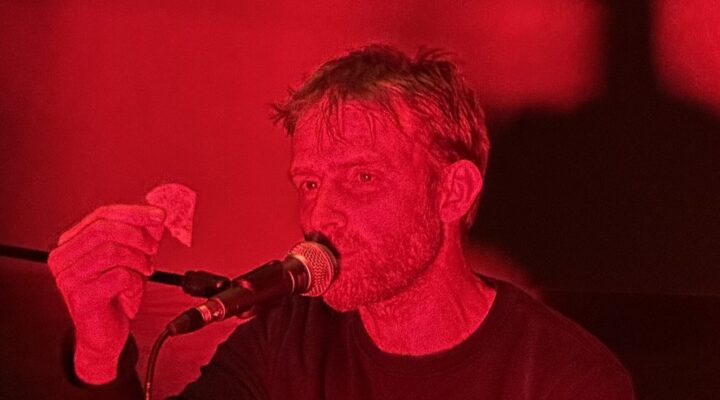Interview with Yaz Lancaster
By Anni Nöps
Photos: Courtesy of Yaz Lancaster
The work of New York’s Yaz Lancaster strikes for its diversity of mediums and genres – an artist truly emblematic of our time. They’re a composer of notated works performed worldwide, a poet, a DJ, a music journalist, an organiser, and one half of the death ambient duo medium.. Throughout the genres, they create art that sublimates fear, trauma, and raw energy while building spaces for community and encouraging risk-taking. Ahead of their performances at the Gaudeamus Festival 2025, we had a chat about their creative process, collaboration and giving agency, love for horror, and why community means more than just putting on shows.

Yaz Lancaster. Photo by Luke Ivanovich
Anni: You’ve been going out a lot in New York lately. How would you describe the city’s music scene right now, both for classical and experimental circles?
Yaz: In New York, there’s always something happening, but in summer it’s doubled. People are more willing to go out, and the variety of both classical concerts to experimental shows is huge.
A: What are your favourite venues to present your works?
Y: Trans-Pecos (shout out to the sound guy Tony!) and Intercomm. And National Sawdust has been really great. They’ve supported my work through all the different aesthetics I have gone through since 2018.
A: One of your works recently premiered in Darmstadt, Germany. How does presenting in Europe compare to New York?
Y: My notated works tend to travel more than I do. I couldn’t go to Darmstadt in person. Sometimes I only find out about a performance when someone sends me a program after it’s taken place. I keep my scores available on my website so anyone can program them.
I work in fragments and collages: pieces of text, titles, visual references. The medium changes, but the process doesn’t.
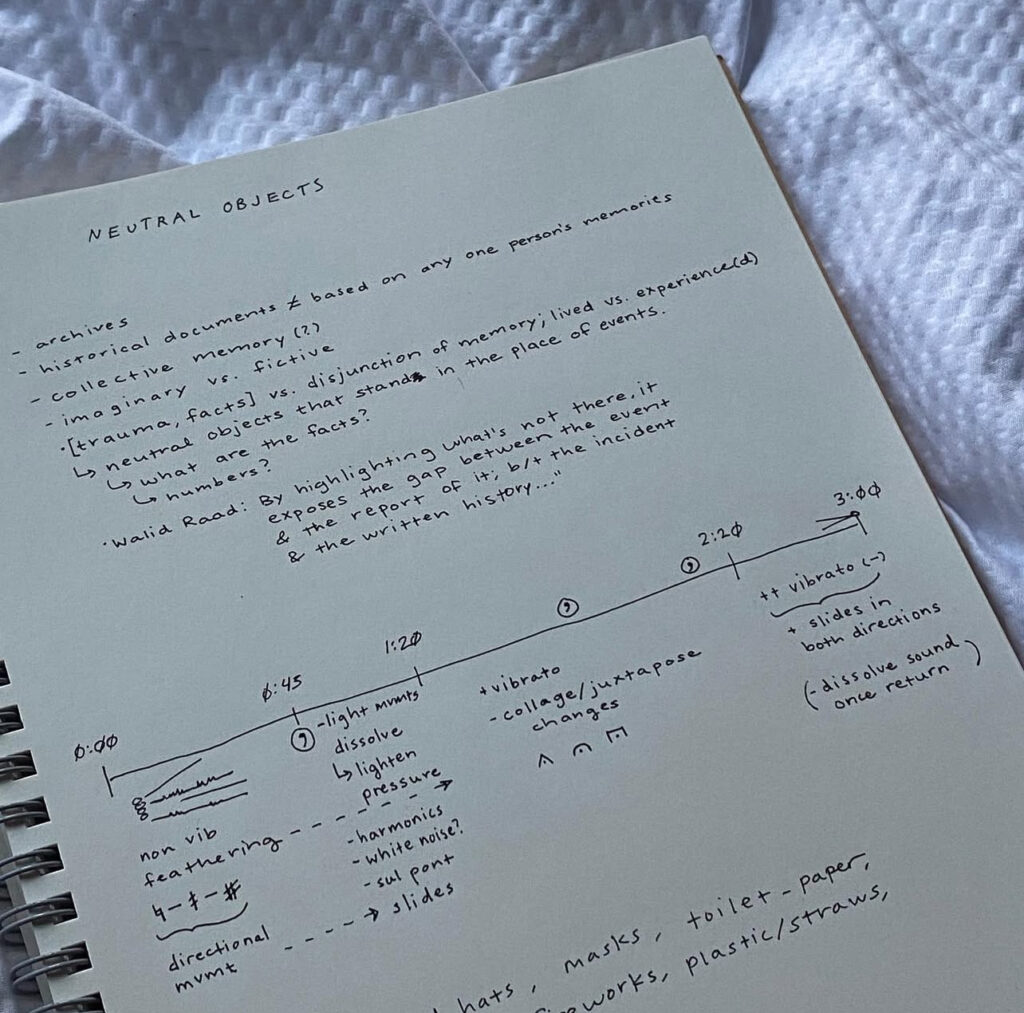
Yaz Lancaster – ‘Neutral Objects’, work process. Listen to the finished composition on YouTube.
A: The variety of your works is striking, ranging from electroacoustic works, digital operas, uptempo DJ sets and pop song covers to poetry and music journalism. Do you see these as separate projects or part of one overarching vision?
Y: It’s all connected. I work in fragments, through piecing together lines of text, titles and visual references. I gather them on paper, then piece them together like a collage. The medium changes, but the process doesn’t.
A: You began as a poet. How did your artistic path lead you to composing?
Y: I actually started with visual art, and thought I would be an illustrator when I was small. Then I discovered writing and poetry, and at eight, I started playing violin. Later during my studies at NYU, I combined performance with sound studies, performance studies, and contemporary art history. Both of my degrees were in violin performance – in undergrad I completed a poetry minor, and in my master’s I took secondary composition lessons.

Yaz Lancaster. Photo by Josh Seiden
A: At Gaudeamus, you’re presenting two works. Could you share more about the work OUROBOROS, commissioned by Beth Morrison Projects. What was your approach?
Y: That piece was really fun to write! The only restriction was that there had to be no visuals, so I created a haunting, fear-driven sound world inspired by my love of horror films.
Behind them, the walls covered in horror movie posters attest to the fact.
A: Fear, fragility and trauma seem central to your work. How do you approach these themes in different mediums – in your notated work and in your duo project?
Y: In notated works, I channel them in more complex, abstract and nuanced ways. With my duo project medium., we channel raw energy from nightclubs or hardcore shows into live ambient-noise sets. Or we straight up play high BPM DJ sets.
When I curate, I ask performers to take risks, like playing evil or freaky versions, to open up a different facet of their artistry.
A: In addition to being an artist, you also organise events – you run HEAVY HEARTS, an experimental music series in New York. What’s your vision for it?
Y: I mix artists from different genres, scenes, and generations, and add non-musical elements like tea, bread, or art vending. My aim is to break the insularity of New York’s music circles. As a central idea, I ask performers to take risks and experiment. For example once I had DJs play evil or freaky versions of what they normally play. It gave the artists an opportunity to tap into a different side of their artistry, resulting in performances I hadn’t experienced before. In the future, I intend to incorporate political elements and conversations as part of the programme.
A: Quite like creating a third space. It seems collaboration and community is a central element of your work.
Y: Community is so much more than just putting on shows. It’s also political and social engagement, daytime activities like protests, fundraising, coat drives, and speaking about abolition from the stage.
Community is so much more than just shows – it’s about daytime activities, organising together, engaging politically and socially
A: How does your work with your death ambient project medium. influence your notated compositions, and vice versa?
Y: medium. Has carved a path for me to compose for longer time forms, and to intentionally incorporate harsher textures, distortion, uglier sounds and noise walls in my solo work. A lot of my earlier work used to incorporate mostly beautiful sounds and shimmering textures, which I love as a string player. As for the influence of classical music on my duo project medium. – we’re both classically trained, gg is a professional vocalist and former opera singer. Our shared classical background lets us communicate ideas and be on the same page, even when improvising.
With medium., we channel raw energy from nightclubs or hardcore shows into live sets.
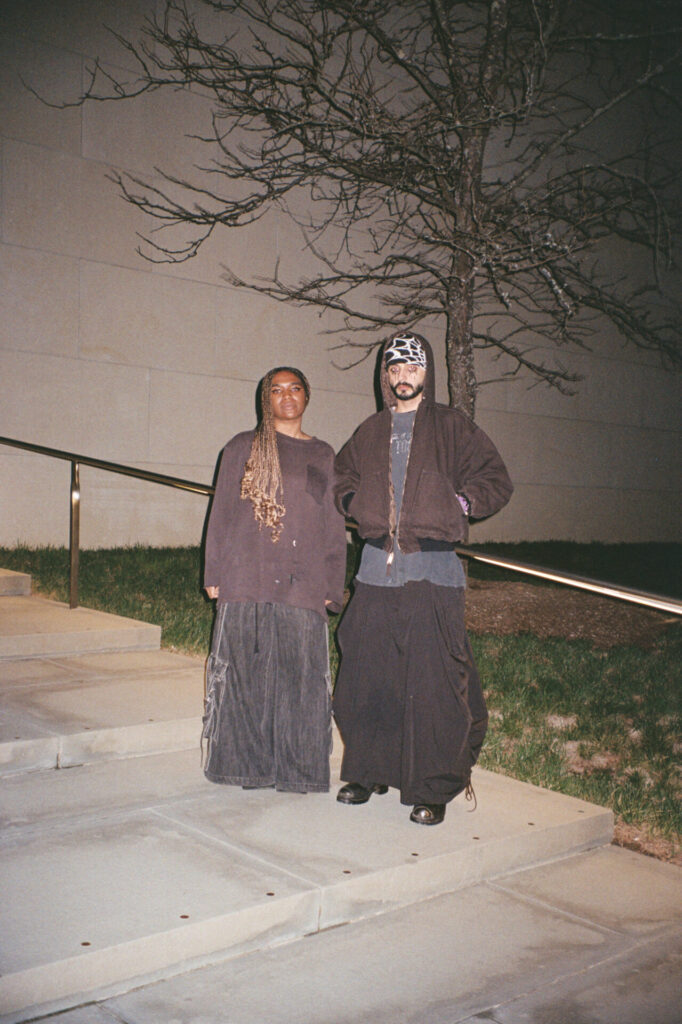
medium., duo project by Yaz Lancaster and gg200bpm. Photo by Kennedy Taylor Dixon.
A: Is medium. always improvised?
Y: We work with loose compositional notes as backbone and create an improv set that we adapt across shows. We may play the same set several times for a few weeks, and then “retire” it. Our instrumentation changes over time, since we both have six or more instruments we use. We often begin with ritual elements like spoken word playback or incense to reset the energy of the space before we start blasting sonically. Our performances are about space and energy. We play as loud as possible, in a way that vibrates the room but is never piercing. Almost every time we play, people end up laying on the ground. People want to be more tactile with the room because of the vibrations. We get interesting responses when we perform, often about really intense emotions.
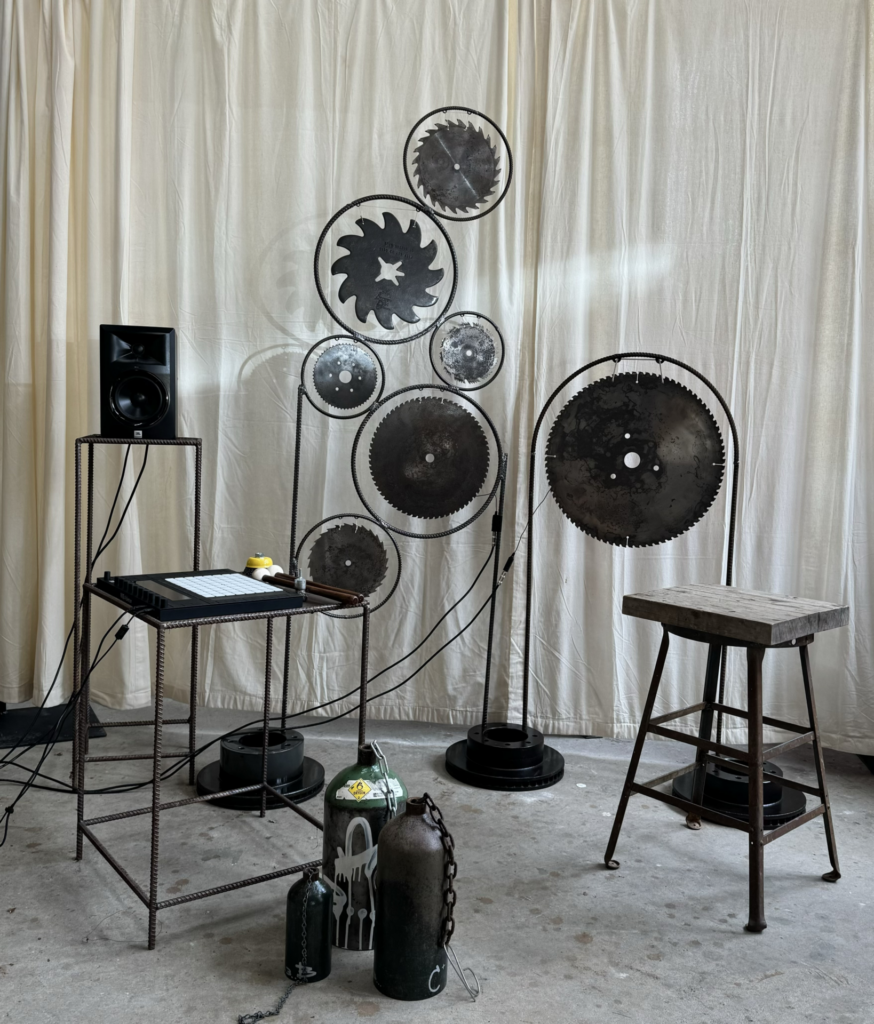
One of gg200bpm’s set-ups with their handmade saw and steel bell instruments
A: I guess it’s connected to the sublimation of the emotions channeled in your work – fragility, fear, trauma. People react to it.
Y: Yeah. I used to cry myself when we would play.
I’ve cried every single time I see Chuquimamani-Condori.
A: Have you ever cried at classical compositions? Or some other works?
Y: I almost cried at the New York premiere of my first orchestral piece, “Solace.”
And I’ve cried every single time I see Chuquimamani-Condori.
A: Who are your current musical influences?
Y: some influential classical/contemporary composers include Leilehua Lanzilotti, George Lewis, Julius Eastman, Andy Akiho, Raven Chacon, Mozart, Cardew, Cage; and my NYU professor Robert Honstein. Other artists I’m currently inspired by are Chuquimamani-Condori & Joshua Chuquimia Crampton, ML Buch, Dreamcrusher, claire rousay and Erika de Casier.
I use open and guided notation to encourage performers to interpret. I see my work as collaboration and giving agency, and I think the audience can feel that.
A: You’ve spoken about liberation in music. What does that mean for you?
Y: I like to use open and guided notation so performers feel encouraged to interpret, to give their own expression. That agency changes the outcome, and I think the audience can feel it. In an upcoming piece with dancers, I want to give agency to the dancers to create part of the music live.
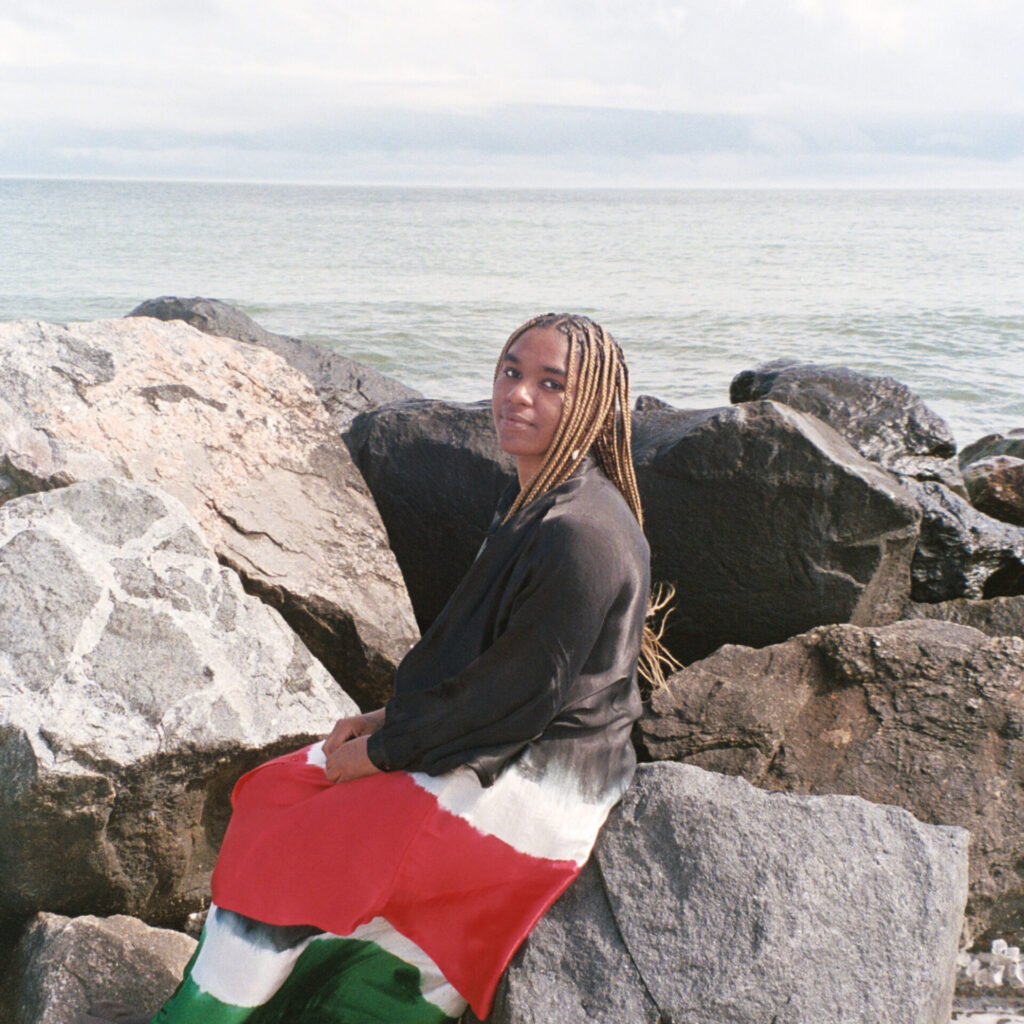
Yaz Lancaster. Courtesy of the artist.
A: What’s next for you?
Y: The dance piece premieres this December in Harlem, NY. In November, my new solo album comes out. It condenses the variety of genres I’m working in – it even has a pop track! In the future, I’d love to do more wild DJ sets, and perhaps release a full pop album that I’d never perform live. But it’s pop with a grain of salt – I don’t even know what genres mean anymore.
Yaz Lancaster is presenting two performances at Gaudemus 2025 in Utrecht. For more information, head to the website of Gaudeamus. Subbacultcha members get access to both evenings at Gaudeamus where their works are presented – Wednesday and Saturday evening programme.


